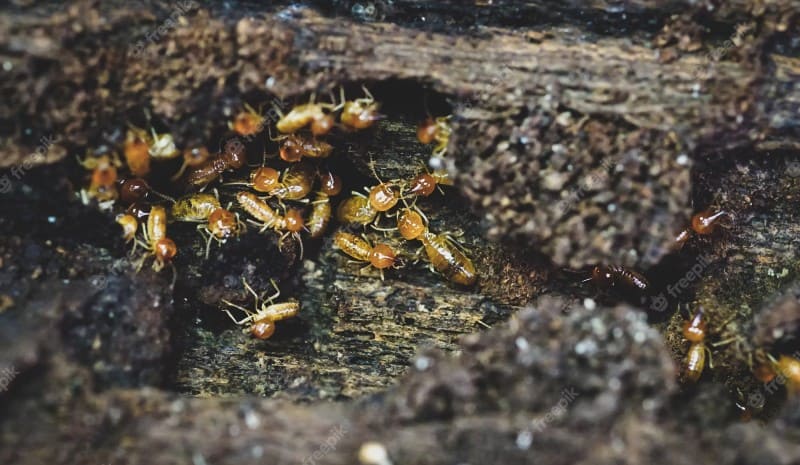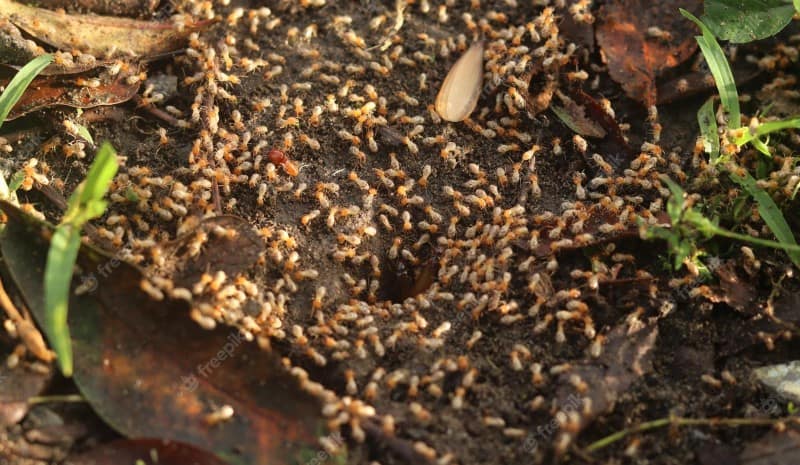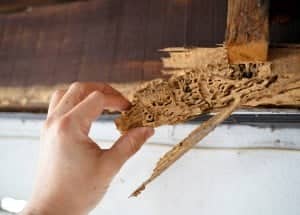Termites Behaviour
Termites are fascinating creatures, known for their unique behavior and feeding habits. Understanding termite behavior is crucial when it comes to preventing and managing termite infestations. Termites feed on a variety of materials, but their diet is largely dependent on several factors, including their species, location, and access to food sources. In this section, we’ll examine the impact of diet on termite behavior and explore the connection between diet and colonization. We’ll also discuss why diet is crucial in termite control and the foods that attract termites. For more information on termite feeding habits and patterns, check out our article on termite feeding habits.

1. The Role of Diet in Termite Behavior
Termites are social insects that rely on diets that are high in cellulose to survive. Their diet mainly consists of wood, but they are omnivorous and can feed on other plant materials as well. The role of diet in termite behavior is crucial as it affects their growth, reproduction, and overall survival. Proper digestion and utilization of food are also important for efficient colony development.
Different termite species have unique nutritional requirements that can determine their preferred food sources. For example, subterranean termites require moist soil and wood to survive, while drywood termites do not need moist soil and can feed on dry wood. A termite’s diet also influences its behavior and activity levels. Some termite species build complex underground structures to access food sources while others modify their landscape to facilitate access to food.
In addition to providing energy and nutrition, the type of food that termites consume also impacts their gut microbiota. Termites have an extensive gut system that contains microorganisms responsible for digesting cellulose. These microorganisms play an important role in helping the termite extract nutrients from their food. They also protect the termite from harmful pathogens and break down toxins present in their food.
Here are some of the key ways that diet influences termite behavior:
- Termite growth and survival: The quality and quantity of food a termite consumes directly affects its growth, survival, and reproductive potential. Termites that consume a well-balanced diet are more likely to produce healthy offspring and grow into a thriving colony.
- Colony development: The availability of food can impact the size and complexity of termite colonies. A colony with limited food resources is likely to be smaller and less developed compared to one with abundant access to food.
- Behavior: The type and location of food sources can influence the behavior of termites. For example, termites that have a plentiful food source nearby are less likely to explore new areas for food. Similarly, the presence of certain repellent or toxic chemicals in their food can influence their feeding behavior.
- Survival and Resistance: The type of food that termites consume can contribute to their resilience and resistance to stress factors such as environmental pollutants and insecticides.
It is important to understand the role of diet in termite behavior to develop effective management strategies. Knowing what termites eat and how they feed is crucial in preventing and controlling termite infestations. You can find more information on what termites eat to help you understand their feeding habits.
2. The Connection between Diet and Colonization
The diet of termites has a significant impact on their ability to colonize and establish thriving nests. The type and quality of food they consume can influence their behavior towards their surrounding environment and even shape the composition of their gut microbes (microorganisms residing in their digestive system).
Subterranean termites, for example, rely on wood and other cellulose-rich materials for survival, so they are more likely to inhabit areas containing an abundant source of such foods. Alternatively, drywood termites have a preference for dry woods and do not require as much moisture as their counterpart, dampwood termites.
The relationship between termites and wood is also of great significance. As wood is the primary source of food for many species of termites, their ability to digest and metabolize cellulose is essential to their survival. Termites have therefore established a mutualistic relationship with protozoa and bacteria present in their gut, which help break down the cellulose molecules into a more digestible form. This is why gut microbes play a crucial role in termite digestion. You may find more information about this in our article about gut microbes and termite digestion.
Termites have the ability to modify their landscape to fit their specific needs. For instance, they often build mud tubes or shelter tubes in order to protect themselves from predators and regulate the temperature and humidity conditions necessary for their survival. These protective structures aid in food sources by allowing termites easier access to food without exposing themselves to the dangers of the environment. Learn more about the modification of landscape by termites in our article about termite landscape modification.
Understanding the connection between diet and colonization can provide valuable insights into controlling and managing termite infestations. By removing or reducing the availability of their favorite foods, homeowners can significantly reduce the risk of termite infestations. For more information about the types of food that termites are attracted to, read our article on subterranean termite diet and termite cellulose nutrition.
Foods That Attract Termites
As we explore the impact of diet on termite behavior, it’s important to understand the types of foods that attract these pests. Termites are attracted to a variety of materials, from wood to moisture-rich substances. In this section, we’ll take a closer look at some of the foods that termites find irresistible and discuss how to identify and prevent infestations. Let’s dive in and discover the key culprits behind termite activity in your home or property.
1. Wood and Cellulose Materials
Termites have a voracious appetite for wood and other cellulose materials. In fact, these are the primary sources of food for termites. Wood and cellulose materials are the most common food sources that attract termites to homes, offices or other structures. The termite’s teeth are designed in a way that they can break down cellulose into simpler compounds, allowing them to get the nutrients they need for survival.
Some of the most commonly attacked wood materials include:
- Softwoods: Termites are particularly attracted to softwoods like pine, spruce, and redwood. These types of woods are widely used in construction and other applications, making them a prime target for termites.
- Hardwoods: Although termites prefer softer woods, they will also attack hardwoods like oak and maple. These trees are often found in older, more established neighborhoods, making homes in these areas more vulnerable to termite infestations.
- Wooden furniture: Termites can infest furniture made of wood, including chairs, tables, and cabinets. Additionally, wooden walls, floors, and support beams are also preferred places for termites to feed on.
It’s important to note that termites don’t just eat the wood, but also the paper products that are made from cellulose, such as books, cardboard, and wallpaper. Homeowners should ensure that any wooden debris or scraps are promptly removed from their property to avoid attracting termites. By identifying and removing the sources of food, homeowners can lower the risk of termite infestations.
2. Moisture-Rich Foods
Moisture-rich foods are another favorite of termites. In fact, termites require moisture to survive and thrive. As such, any food source that is rich in moisture can become a potential target for these insects. Some examples of moisture-rich foods that termites are attracted to include:
| Foods | Description |
|---|---|
| Leaky Pipes | Termites are attracted to leaky pipes because of the moisture they provide. Pipes that are old or damaged may leak water, providing the necessary moisture for termites to feed and grow their colonies. |
| Damp or Wet Wood | If you have damp or wet wood in your home, it can become a prime target for termites. These pests are attracted to wood that is moist because it contains the necessary nutrients for their survival. |
| Plant Debris | Termites will eat away at any plant debris left around your home, especially after rainfall. The debris retains the moisture, which termites need in order to survive. |
| Clogged Gutters | Gutters that are clogged with debris tend to overflow when it rains. Such conditions can attract termites because the damp soil around the house provides the necessary moisture for their survival. |
It is essential to keep moisture-rich areas of your home dry and free of clutter to prevent termites from infesting them. Regularly checking your pipes, gutters, and drains for leaks or obstructions can reduce the likelihood of creating a habitat that is conducive to termite growth. Ensuring your drainage system functions correctly can help keep your home free of moisture, which makes it less attractive to termites.

3. Other Termite Favorites
Termites are notorious for their love of wood and cellulose materials, but they also have other favorite foods. Here are some of the lesser-known foods that termites find particularly delectable:
- Drywall: Drywall is made of paper, which contains cellulose – a termite’s favorite snack. Termites can easily chew through drywall to reach the paper layer inside.
- Cardboard: Like drywall, cardboard contains cellulose and is therefore irresistible to termites. Make sure to remove any cardboard boxes or packing materials from your home as soon as possible.
- Cotton: While less commonly known, termites have been known to feed on cotton products such as clothes, towels, and even cotton insulation.
- Plants and Trees: Termites are omnivores and will gladly munch on living plants and trees if given the opportunity. This can cause serious damage to agricultural crops and backyard gardens.
It’s important to remember that termites are constantly on the hunt for new food sources, and any organic material could potentially attract them. Regular inspections and maintenance of your property can help prevent termite infestations and limit the damage they can cause.
Conclusion
In conclusion, it is abundantly clear that the impact of diet on termite behavior cannot be underestimated. As we have seen, termites are primarily attracted to wood and cellulose-based materials, as well as moisture-rich foods. Understanding the connection between diet and termite behavior is essential when it comes to termite control and management strategies.
If left unchecked, termite infestations can result in significant structural damage to homes and buildings, costing homeowners thousands of dollars in repairs. Prevention and early identification of termite infestations are therefore critical in mitigating the risk of damage.
As such, it is crucial for homeowners to be aware of the various foods that attract termites, such as firewood, mulch, and other wood-based materials. By taking steps to limit access to these foods and reducing moisture levels in and around the home, homeowners can help deter these pests from taking up residence.
Overall, the importance of diet in termite behavior cannot be overstated, and it is essential for homeowners and pest control professionals alike to understand this relationship in order to effectively manage termite infestations and protect their properties.
Frequently Asked Questions
1. How does the diet of termites affect their behavior?
The diet of termites can affect their behavior by influencing their foraging, feeding habits, and the expansion of their colonies.
2. Do all termites have the same diet?
No, different species of termites have different diets. However, most termites feed on cellulose-rich materials like wood, leaves, and grass.
3. Can termite behavior be controlled through diet modification?
Yes, modifying the diet of termites can be one way of controlling their behavior. For instance, baiting systems can be used to attract termites to a food source laced with a slow-acting poison that is carried back to the colony, eventually affecting the entire population.
4. What foods should you avoid to prevent a termite infestation?
You should avoid storing firewood, cardboard boxes, and other cellulose-rich materials near your home as these can attract termites. Also, fixing leaky pipes and gutters can help prevent moisture accumulation, which is another factor that can attract termites.
5. Can termites survive without their preferred food source?
It is unlikely that termites can survive without their preferred food source. They can only digest cellulose and other complex carbohydrates found in wood, plants, and some fibers.
6. Are there any natural ways to deter termites from your home?
There are some natural ways to deter termites from your home, such as using natural termite repellents like orange oil, neem oil, and vinegar. However, these remedies are not scientifically proven to be effective.
7. Can termites be beneficial to the ecosystem?
Yes, termites play an important role in the ecosystem by breaking down dead plant material and enriching the soil with nutrients. Additionally, some termites are used in scientific research and for medicinal purposes.
8. How can you identify a termite infestation?
You can identify a termite infestation by looking out for signs such as mud tubes or tunnels, piles of wings, damaged or hollow-sounding wood, and visible sightings of termites.
9. Does having a termite infestation mean your home is dirty or unkempt?
No, having a termite infestation does not implicitly mean that your home is dirty or unkempt. Termites can infest both clean and dirty homes as long as there is a food source and moisture.
10. How frequently should you inspect your home for termites?
You should inspect your home for termites at least once a year. However, if you live in an area prone to termite infestations, you may want to schedule more frequent inspections.

